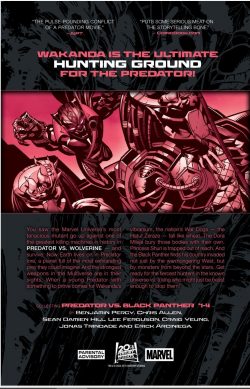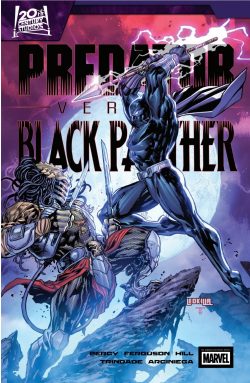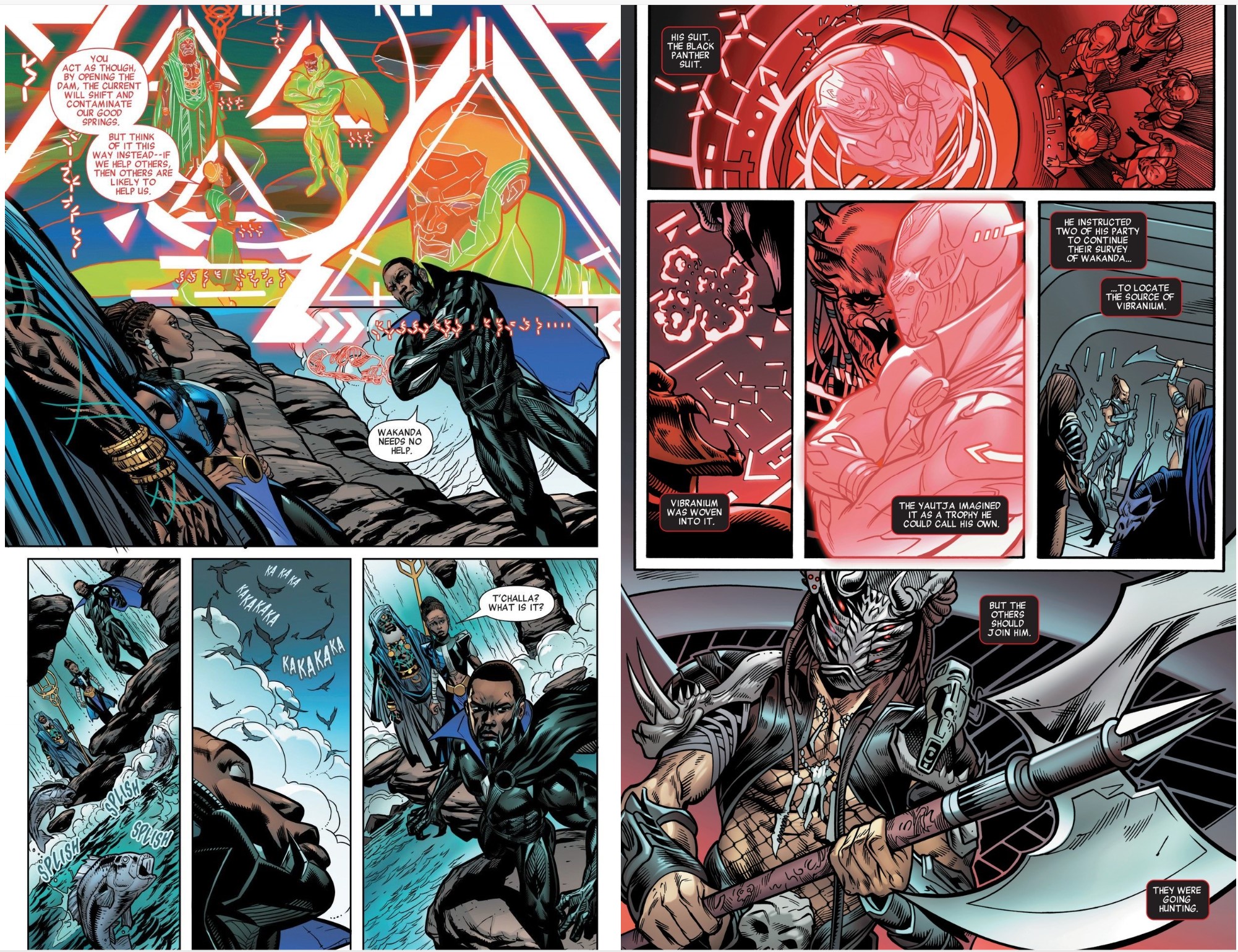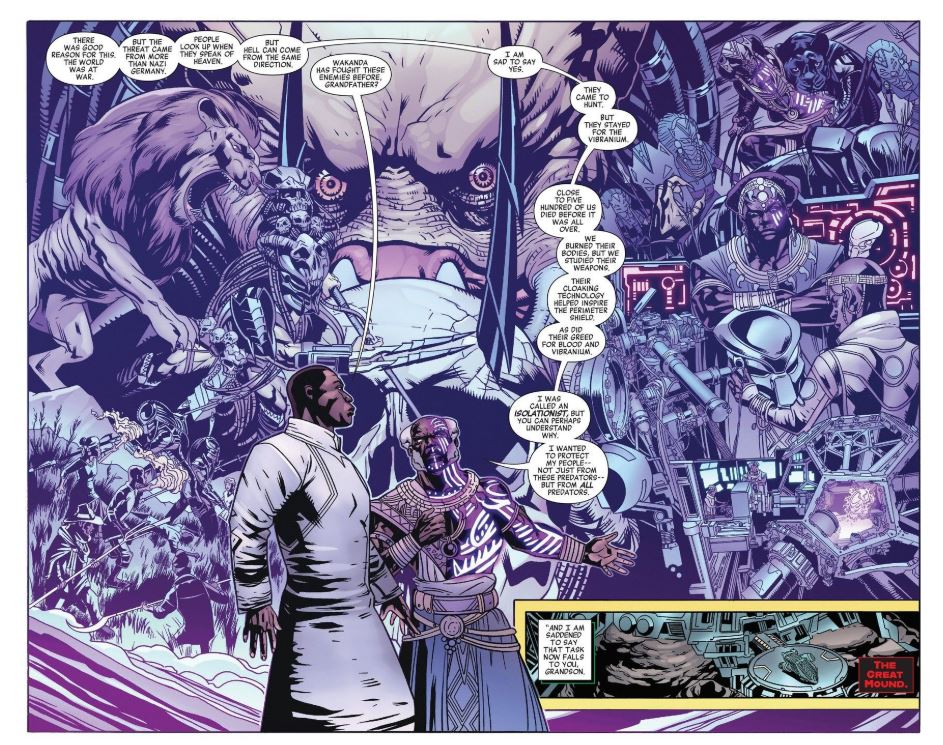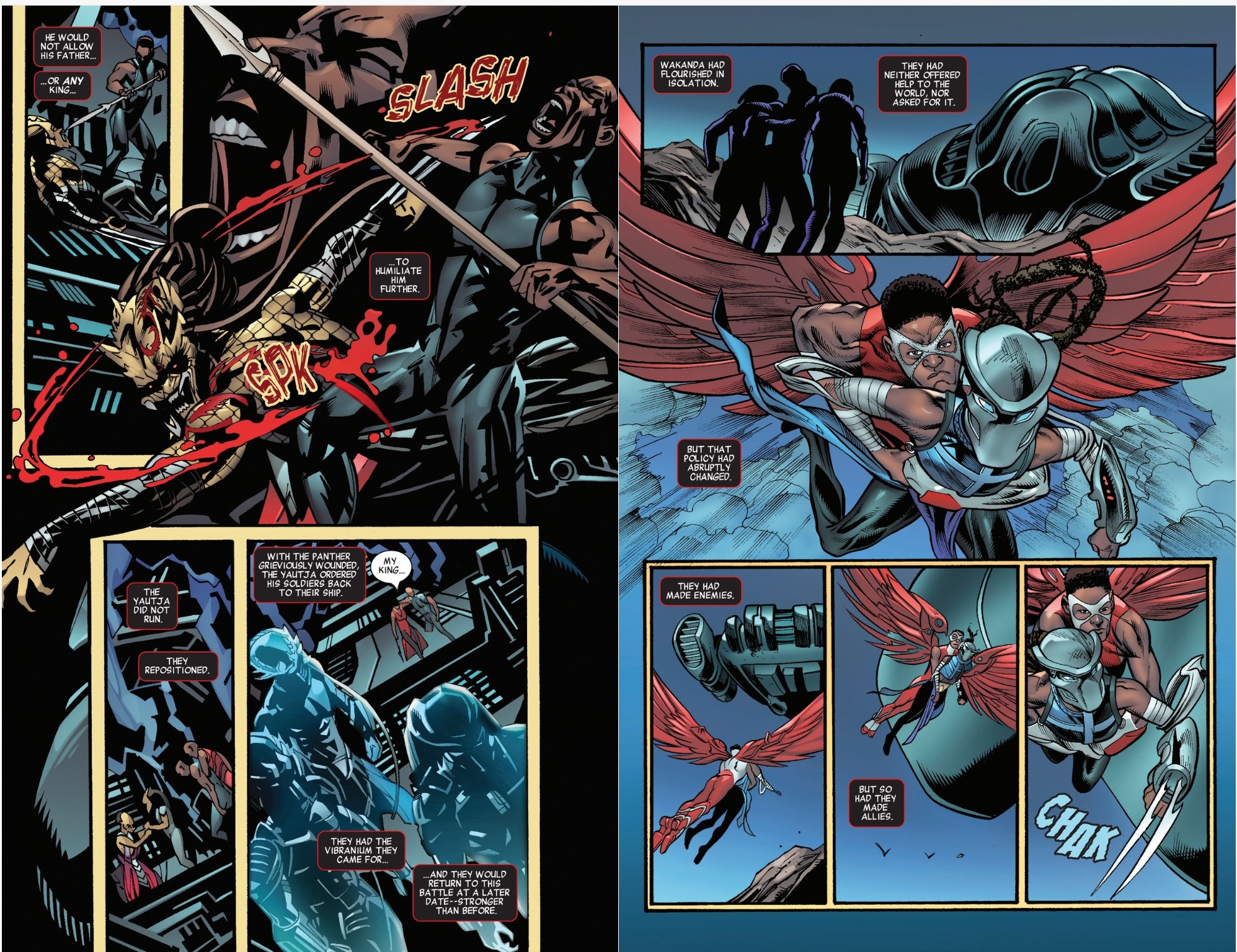

By Steve Englehart, Jack Kirby, John Warner, Tony Isabella, Bill Mantlo, Marv Wolfman, Frank Robbins, Sal Buscema, Herb Trimpe, Vince Colletta, Frank Giacoia, D. Bruce Berry, Joe Giella, Mike Esposito, Frank Chiaramonte Barry Windsor-Smith John Romita, John Verpoorten, Dan Adkins, John Byrne, Joe Sinnott, Marie Severin, Charley Parker, Bob Budiansky, Paty Cockrum, & various (MARVEL)
ISBN: 978-1-3029-4873-3 (TPB/Digital edition)
This book includes Discriminatory Content produced in less enlightened times.
It’s customary – right here at least – to end our year with bit of timey-wimey extrapolation and conjecture, or celebrate an anniversary. However, due to the parlous state of global existence, I’ve instead opted for political pontificating. I decided that with the horror of the next four years barely begun, it’s time to stand tallish and make a sly whiny statement and see who even notices…
Created by Joe Simon & Jack Kirby in an era of ferocious patriotic fervour and carefully-manipulated idealism, Captain America was a dynamic and exceedingly bombastic response to the horrors of Nazism and the threat of Liberty’s loss.
He quickly lost focus and popularity once hostilities ceased: fading away as post-war reconstruction began. He briefly reappeared after the Korean War: a harder, darker sentinel ferreting out monsters, subversives and the “commies” who lurked under every American bed. Then he vanished once more until the burgeoning Marvel Age resurrected him just in time to experience the Land of the Free’s most turbulent and culturally divisive era. Here the Star-Spangled Avenger was in danger of becoming an uncomfortable symbol of a troubled, divided society, split along age lines and with many of the hero’s fans apparently rooting for the wrong side. Now into that turbulent mix crept issues of racial and gender inequality…
Cap had quickly evolved into a mainstay of the Marvel Revolution during the Swinging Sixties but lost his way somewhat after that, except for a glittering period under writer Steve Englehart. Eventually however, in the middle of the decades, that enlightened voice-of-a-generation scribe also moved on and out. Meanwhile, after nearly ten years drafting almost all of Marvel’s successes, Jack Kirby had jumped ship to arch-rival DC in 1971, creating a whole new mythology, dynamically inspiring pantheon and new way to tell comics stories. Short term though, cowardly editorial practices and lack of support had convinced him that DC was no better than Marvel for men of vision. Eventually, he accepted that even he could never win against any publishing company’s excessive pressure to produce whilst enduring micro-managing editorial interference.
Seeing which way the winds were blowing, Kirby exploded back into the Marvel Universe in 1976 with a signed promise of free rein to concoct another stunning wave of iconic creations – licensed movie sensations such as 2001: a Space Odyssey (and – so very nearly – seminal TV paranoia-fest The Prisoner); Machine Man; Devil Dinosaur and The Eternals. He was also granted control of two of his previous co-creations – firmly established characters Black Panther and Captain America to do with as he wished…
His return was much hyped at the time but swiftly became controversial since his intensely personal visions paid little lip service to company continuity: Jack always went his own bombastic way. Whilst those new works quickly found many friends, his tenure on those earlier inventions drastically divided the fan base. Kirby was never slavishly wedded to tight continuity and preferred, in many ways, to treat his stints on Cap and the Panther as creative “Day Ones”. That was never more apparent than for the Star-Spangled Sentinel of Liberty…
This resoundingly resolute rabble rousingly rambunctious sixth full-colour Epic Collection re-presents Captain America and the Falcon #180-200 and 1976’s colossal Marvel Treasury Special: Captain America’s Bicentennial Battles, cover-dated December 1974 to August 1976: spanning and neatly wrapping up the post-Englehart period and revealing how, when Kirby came aboard as writer, artist and editor, he had big plans for the nation’s premiere comicbook patriotic symbol in the year of its 200th anniversary…
At this time the US was a nation reeling from loss of idealism caused by Vietnam, Watergate and the (then partial) exposure of President Richard Nixon’s crimes. The general loss of idealism and painful public revelation that politicians are generally unpleasant – and even potentially ruthless, wicked exploiters – kicked the props out of most Americans who had an incomprehensibly rosy view of their leaders. Thus, Cap’s exposing a conspiracy reaching into the halls and backrooms of government to undemocratically seize control of the country by deceit and criminal conspiracy (sounds like sheer fantasy these days, doesn’t it?) was extremely controversial but compellingly attractive in those distant, simpler days. Now after doing what was necessary, the idealistic hero could no longer be associated with a tarnished ideal…
Previously: the Sentinel of Liberty had become a lost symbol in and of a divided nation. Uncomfortable in his red, white and blue skin but looking to carve himself a new place in the Land of the Free he is also unable to abandon the role of do-gooder. When Steve Rogers is convinced by Avenging comrade Hawkeye that he could still serve his country and people even if he can’t be a star-spangled representative of America, it sparks a life-changing decision in opening tale ‘The Coming of the Nomad!’ Sadly, survivors of the sinister Serpent Squad (Cobra and The Eel) return with psychotic Princess Python in tow and maniac nihilist Madame Hydra murderously assuming the suddenly vacant leader’s role as a new Viper. When Rogers – as Nomad, “the Man Without a Country” – tackles the ophidian villains, he battles ineptly and fares badly but still stumbles across a sinister scheme by the Squad and Sub-Mariner’s arch-nemesis Warlord Krang. That subsea tyrant – in the thrall of ancient evil force the Helmet of Set – seeks to raise a sunken continent and restore an ancient civilisation in ‘The Mark of Madness!’ Elsewhere at the same time, former partner Sam Wilson/The Falcon is ignoring his better judgement and training determined young Roscoe Simons to become the next Captain America…

A glittering era ended with #182 as artist Sal Buscema moved on and newspaper-strip star Frank Robbins came aboard for a controversial run, beginning with ‘Inferno!’ (inked by Joe Giella). Whilst Nomad successfully mops up the Serpent Squad – despite well-meaning police interference – Sam and Cap’s substitute Roscoe encounter the Sentinel of Liberty’s greatest enemy with fatal consequences. The saga shifts into top gear as ‘Nomad: No More!’ (Frank Giacoia inks) sees shamed, grief-stricken Rogers once more take up his star-spangled burden after the murderous Red Skull simultaneously attacks the hero’s loved ones and dismantles America’s economy by defiling the banks and slaughtering the financial wizards who run them.
Beginning in the chillingly evocative ‘Cap’s Back!’ (art by Herb Trimpe, Giacoia & Mike Esposito), rampaging through the utterly shocking ‘Scream of the Scarlet Skull!’ (Sal Buscema, Robbins & Giacoia), it all climaxes in ‘Mindcage!’ (with additional scripting by John Warner and art by Robbins & Esposito) wherein our titular hero’s greatest ally is apparently revealed as his enemy’s stooge and slave. As the Red Skull, in all his gory glory, gloatingly reveals that his staggeringly effective campaign of terror was as nothing to his ultimate triumph, we learn that the high-flying Falcon has been his unwitting secret weapon for years. The staunch ally was originally cheap gangster “Snap” Wilson, radically recreated and reprogrammed by the Cosmic Cube to be Captain America’s perfect partner; and a tantalising, ticking time bomb waiting to explode…
Captain America and the Falcon #187 opens on ‘The Madness Maze!’ (Warner, Robbins & Frank Chiaramonte) with the Skull recently-fled and a now-comatose Falcon in custody of superspy agency S.H.I.E.L.D. Abruptly, the Star-Spangled Avenger is abducted, snatched by by a mysterious flying saucer and latterly attacked by alchemical androids employed by a rival espionage outfit, culminating in a ‘Druid-War’ (Warner, Sal B & Colletta), before Tony Isabella, Robbins & Chiaramonte put Cap into an ‘Arena For a Fallen Hero!’ where deception, psychological warfare and unarmed combat combine into a risky shock therapy to kill or cure the mind-locked Sam Wilson. However, just as the radical cure kicks in, an old foe takes over S.H.I.E.L.D.’s flying HQ in ‘Nightshade is Deadlier the Second Time Around!’ (Isabella, Robbins & Colletta). Once she’s defeated, the past crimes of forcibly-reformed Snap Wilson are reviewed and judged in an LA courtroom in climactic wrap-up ‘The Trial of the Falcon!’ (Isabella, Bill Mantlo, Robbins & D. Bruce Berry): proffering a predictable court ruling, a clutch of heroic cameos and a bombastic battle against the sinister Stilt-Man – hired by mob bosses to ensure Snap’s silence on his gangland activities…

Narrative decks cleared, CAatF #192 delivered an ingenious, entertaining filler written by outgoing editor Marv Wolfman, illustrated by Robbins & Berry, wherein Cap hops on a commercial flight back to the East Coast and finds himself battling deranged psychiatrist Dr. Faustus and a contingent of mobsters on a ‘Mad-Flight!’ thousands of feet above New York. With all plots safely settled, the stage was set for the return of Cap’s co-creator: returning with a bombastic fresh take that would take the Sentinel of Liberty into regions never before explored…
It begins with Captain America and the Falcon #193, offering the opening salvo in an epic storyline leading up the immortal super-soldier’s own Bicentennial issue (sort of). Gone now was all the soul-searching and breast-beating about what the country was or symbolised: The USA is in peril and its sentinel was ready to roar into action…
Inked by fellow veteran Frank Giacoia ‘The Madbomb’ exposes a ‘Screamer in the Brain!’ as a miniscule new weapon is triggered by unknown terrorists, reducing an entire city block to rubble by driving the populace into a mass psychotic frenzy. Experiencing the madness at close hand, Cap and the Falcon are swiftly seconded by the US government to ferret out the culprits and find a full-scale device hidden somewhere in the vast melting pot of America…
‘The Trojan Horde’ introduces plutocratic mastermind William Taurey who intends to correct history, unmaking the American Revolution and restoring a privilege-ridden aristocracy upon the massed millions of free citizens. Using inestimable wealth, a cabal of similarly disgruntled billionaire elitists (what a ree-dicalus ideah!), an army of mercenaries, slaves cruelly transformed into genetic freaks and other cutting-edge super-science atrocities, the maniac intends to forever eradicate the Republic and plunder the resources of the planet. Thank every god you know that it couldn’t happen today…
Moreover, when he is finally elevated to what he considers his rightful place, the first thing Taurey intends to do is hunt down the last descendent of Colonial-era hero Steven Rogers: a rebel who had killed Taurey’s Monarchist ancestor and allowed Washington to win the War of Independence. Little does he suspect the subject of his wrath has already infiltrated his secret army…

Inked by D. Bruce Berry, in ‘It’s 1984!’ Cap & Falcon get a firsthand look at the kind of fascistic world Taurey advocates, battling their way through monsters, mercenaries and a mob fuelled by modern mind-control and pacified by Bread & Circuses, before ultra-spoiled elitist Cheer Chadwick takes the undercover heroes under her bored, effete and patronising wing. Sadly, even she can’t keep her new pets from being sucked into the bloody, brutal Circus section of the New Society, where American loyalists are forced to fight for their lives in ultra-modern gladiatorial mode in the ‘Kill-Derby’, even as the US army raids the secret base in Giacoia inked ‘The Rocks are Burning!’ Soon, the Patriotic Pair realise it has all been for nought since the colossal full-sized Madbomb is still active: carefully hidden somewhere else in their vast Home of the Brave…
The offbeat ‘Captain America’s Love Story’ then takes a decidedly different and desperate track as the Bastion of Freedom must romance a sick woman to get to her father – the inventor of the deadly mind-shattering device – after which ‘The Man Who Sold the United States’ accelerates to top speed for all-out action as the hard-pressed heroes race a countdown to disaster with the Madbomb finally triggering by ‘Dawn’s Early Light!’ for a spectacular showdown climax that truly surpasses all expectation.
This compilation compellingly concludes with a once in a lifetime special event. Captain America’s Bicentennial Battles was originally released (on June 15th 1976) as part of the nationwide celebration of the USA’s two hundredth year. One of Marvel’s tabloid-sized “Treasury Format” (80+ pages of 338 x 258mm dimensions) titles, it took the Star-Spangled Avenger on an incredible excursion through key eras and areas of American history. An expansive, panoramic and wildly iconic celebration of the memory and myth of the nation, this almost abstracted, deeply symbolic 84-page extravaganza perfectly survives reduction to standard comic dimensions, following Captain America as cosmic savant – and retrofitted Elder of the Universe The Contemplator – Mister Buda propels the querulous hero into successively significant slices of history. Enduring a blistering pace of constant change, Cap encounters lost partner Bucky during WWII, meets Benjamin Franklin in Revolutionary Philadelphia and revisits the mobster-ridden depression era of Steve Roger’s own childhood as ‘The Lost Super-Hero!’.

In ‘My Fellow Americans’, Cap confronts Geronimo during the Indian Wars and suffers the horrors of a mine cave-in, before ‘Stop Here for Glory!’ finds him surviving a dogfight with a German WWI fighter ace, battling bare-knuckle boxer John L. Sullivan, resisting slavers with abolitionist John Brown, and observing both the detonation of the first Atom Bomb and the Great Chicago Fire. ‘The Face of the Future!’ even sees him slipping into the space colonies of America’s inevitable tomorrows, and segueing into pure emotional fantasy by experiencing the glory days of Hollywood, the simple joys of rural homesteading and the harshest modern ghetto, before drawing strength from the nation’s hopeful children…
Inked by such luminaries as Barry Windsor-Smith, John Romita Sr., Herb Trimpe and Dan Adkins, the book length bonanza comes peppered with a glorious selection of pulsating pin-ups.
With covers throughout by Gil Kane, Kirby, Giacoia, Esposito, Joe Sinnott, Ron Wilson, John Romita (Sr.), Sal Buscema &John Verpoorten, this supremely thrilling collection also has room for a selection of bonus treats beginning with the Kane & Esposito cover for reprint title Giant-size Captain America #1 (1975); relevant Cap & Falcon pages from Mighty Marvel Calendar for 1975 ((July, by John Romita); the Marvel Bullpen Bulletins page announcing the King’s return in all October issues, and assorted house ads. Also on view are extracts and articles from company fanzine F.O.O.M. #11, September 1975; an all-Kirby issue declaring – behind a Byrne/Joe Sinnott cover – that “Jack’s back!”. Material includes ‘The King is Here! Long Live the King!’, ‘Kirby Speaks!’, stunning artwork from 2001: A Space Odyssey, Alex Boyd’s appreciation ‘The Once and Future King!’, Charley Parker’s ‘The Origin of King Kirby’, ‘Kirby’s Kosmik Konsciousness’ and a caricature from the wonderful Marie Severin.
Also on show are cover roughs and un-inked pencils to delight art fans and aficionados, as well as original page art by Kirby inked by Giacoia & Windsor Smith.
King Kirby’s commitment to wholesome adventure, breakneck action and breathless wonderment, combined with his absolute mastery of the medium and unceasing quest for the Next Big Thrill, always make for a captivating read and this stuff is amongst the most bombastic and captivating material he ever produced. Fast-paced, action-packed, totally engrossing Fights ‘n’ Tights masterpieces no fan should ignore and, above all else, fabulously fun tales of a true American Dream and a perfect counterpoint and exemplar to the moodily insecurity of the Englehart episodes that precede them here. Despite the odd cringeworthy story moment (I specifically omitted the part where Cap battles three chicken-themed villains for example, and still wince at some of the dialogue from this forthright and earnest era of “blaxsploitation” and emergent ethnic awareness), these tales of matchless courage and indomitable heroism are fast-paced, action-packed, totally engrossing fights ‘n’ tights no comics fan should miss, and joking aside, their cultural significance is crucial in informing the political consciences of the youngest members of post-Watergate generation, and so much more so today…
© 2024 MARVEL.
